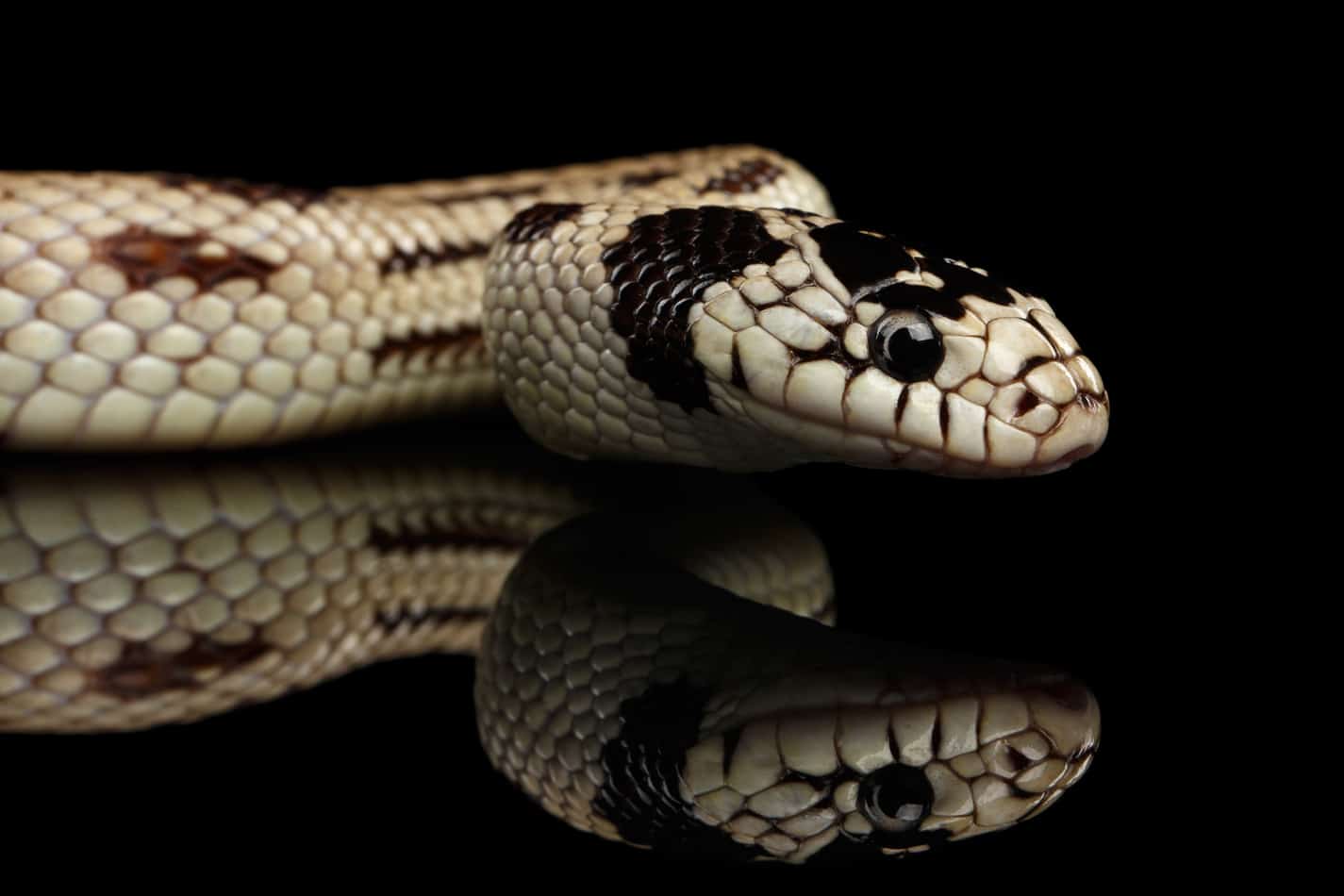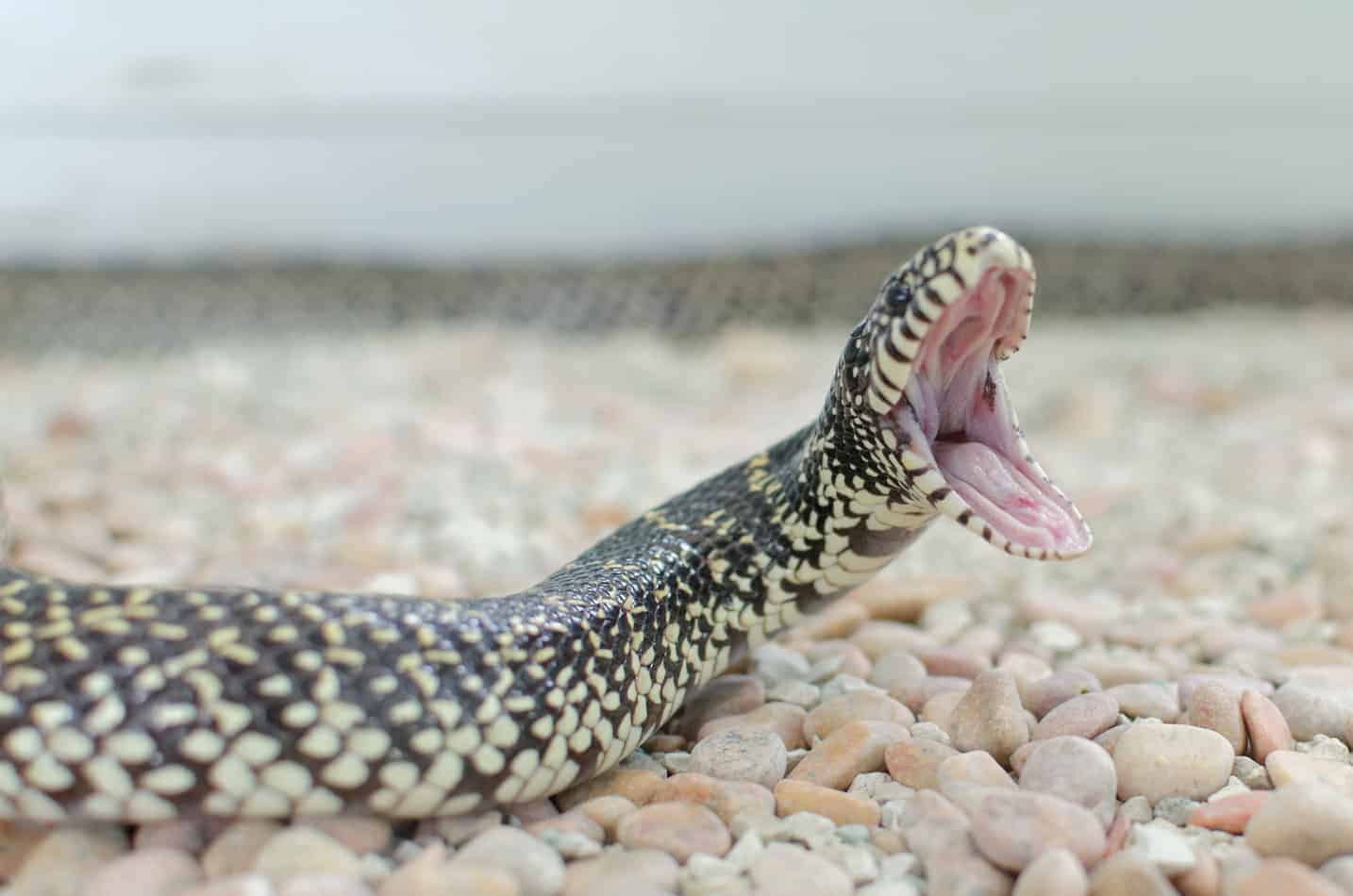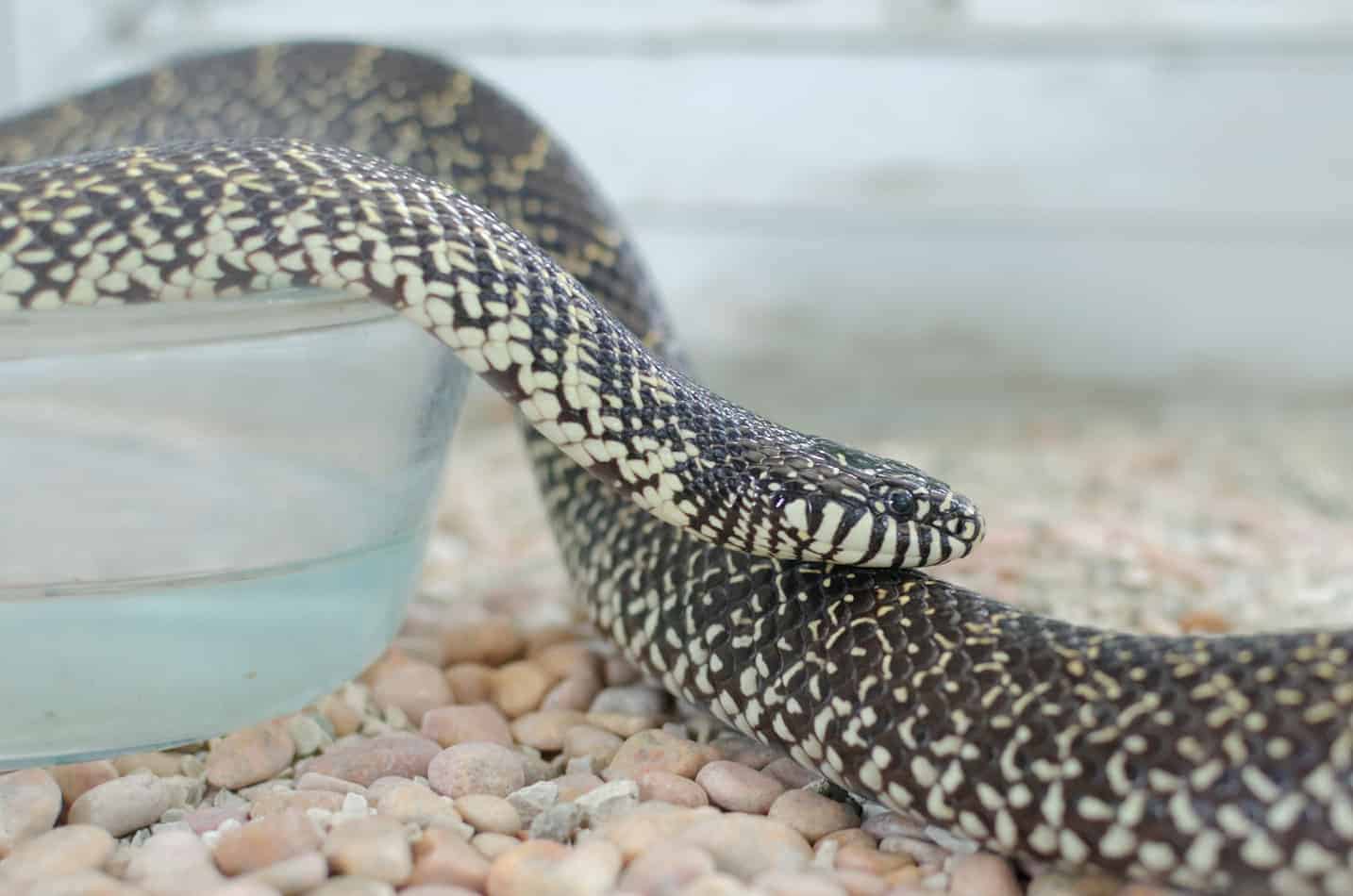California King Snakes: Facts with Pictures and Video
California King Snakes are one of the most common snakes found as a pet in the homes of various snake-lovers across the United States. I have found that the California King Snake is one of, if not the best, pet snake species to adopt into one’s lifestyle and home as a pet.
What Makes The California King Snake So Great?
You may ask, what makes the California King Snake so great? The California King Snake is a non-venomous, easily adaptable, and low maintenance pet. The convenience of such a pet is the reason it is such a draw for many individuals or families who are looking to become pet owners or widen the number of pets in their home.
This reasoning is only scraping the surface of the positives behind this great reptilian species, there are so many reasons and fun facts that you would be pleased to find that the California King Snake is the perfect snake for you.
Facts About a California King Snake’s Habitat in the Wild
The California King Snake can be found mainly in the Western United States in the coastal and desert states of Oregon, Nevada, California, Colorado, New Mexico, and Arizona. These snakes can also be found in Baja California and North Western Mexico.
These snakes can adapt well in many different habitats such as marshes, forests, grasslands, deserts, and even some suburban areas that are in shrubby and bushy environments.
Because these snakes’ habitats are found in most mountainous areas, they can be found in elevated areas up to seven-thousand feet! The California King Snake can also be found under leaf litter and some abandoned man-made structures like wood or metal piles.
Characteristics of a California King Snake

The California King Snake has many likable characteristics. This non-venomous constrictor can be found to grow between two and a half to four feet in length and can have many different colors and striped patterns.
These snakes usually come in shades of black or brown with their stripes having the appearance of either white or light yellow. Their stripes can either be horizontal across their body or vertical down the length of their body.
Their smooth shiny scales can host many different combinations of the patterns listed above. No one snake ever will look the same, so you can be sure that your snake is very unique in both its patterning and personality.
In the wild, these snakes have rightfully earned their name. The California King Snakes are seen as kings because they are exactly that, the king of their food chain. They are kings because they will attack and kill other snakes that threaten them or even because they are looking for a meal.
Something interesting about these snakes is that while they are non-venomous snakes they also are immune to most venom from snakes like the rattlesnake which gives them an even better advantage to their claimed name.
Even though they are non-venomous, these snakes are constrictors. This means that instead of biting and injecting their prey with venom to disable and then kill, they wrap their body around their planned meal or threat and constrict, thoroughly suffocating and killing their prey.
While the lifespan of the California King Snake in the wild varies, the lifespan of this snake as a pet in captivity can range between twenty and thirty years! When buying a snake be sure to recognize that this will be a very long-term commitment.
Facts About California King Snake Behavior and Handling

While the behavior of a wild California King Snake may sound a seem a bit intimidating, worry not because these snakes as pets are far different in trained captivity than as purely wild snakes you would find in the woods or desert.
In a captive environment, California King Snakes are very docile once they become adjusted to their new home environment and habitat and also once they are used to their handlers/owners.
These mostly solitary snakes are diurnal terrestrials. This means that they are awake most of the day and sleep at night (diurnal), and that they dwell mostly on the ground and sometimes climb low branches off of plants like bushes and other shrubberies (terrestrial).
Sometimes when it is very hot they will turn temporarily nocturnal but this is unlikely to happen if their habitation is kept at a decent and steady temperature that is right for your snake.
When it comes to handling your California King Snake, start slow with patience and eventually your snake will learn to trust you and you will be able to handle them with ease and comfort. When your snake is uncomfortable or agitated you will be able to tell by certain signs it gives off.
When agitated, if you are handling your snake, they may smear feces or urine on you as a sign of discomfort. Another possibility as a sign of agitation is, like most snakes, California King Snakes may shake their tales as a warning sign before striking.
It is important to remember that even though your snake is a pet and may have been bred in captivity for generations, it is still fully capable of being wild and acting like a wild snake and a predator.
A common time when the California King Snake may strike is before, during, and after its shedding process. California King Snakes shed between four and six times a year. During this time their skin becomes very sensitive as they start to shed and extremely sensitive as their new skin is realized.
They may also strike because during the shedding process their eyes turn a milky white color which causes them to be almost blind during this time. It is nothing to be alarmed about, only part of the shedding process. This may cause intimidation and tenseness because they can not see who or what is touching or handling them.
It is advised that you be aware of your snake’s shedding schedule and do not handle them during this time for both the comfort and safety of you and your snake.
It should also be noted that it is not recommended that you handle your snake immediately after it is fed, your snake should be given time to digest its food.
If your pet snake strikes and bites you, return your snake to its cage or terrarium and immediately tend to your wound by cleaning it properly and wrapping it so it does not get infected and cause you further injury.
It is important to remember that even though your snake is a pet and may have been bred in captivity for generations, it is still fully capable of being wild and acting like a wild snake and a predator. Always pay attention to the signs and
Facts About a California King Snake’s Diet

The California King Snake is capable of having both a very varied diet and a carefully considered diet which may only consist of one or a few things on a regular basis.
In the wild, the California King Snake’s diet can consist of smaller mammals and reptiles such as other snakes (as previously mentioned, turtles, birds, bird eggs, lizards, frogs, and rodents. California King Snakes have been known to eat a rattlesnake whole while it is still alive.
In captivity, you will find that the California King Snake’s diet is fairly different than their wild counterparts. Other than as pets, you may find that your nearest California King Snake you can view can be at a local or city zoo. Mainly in zoos, the dietary food and meals that are fed to this snake consist of mice.
In captivity as a pet, you may feed your snake small rodents like mice (this is the most common food that is fed to King Snakes like the California King). The California King Snake has a hinged jaw which allows this snake to swallow prey that is bigger than its snake’s head!
While you have the option to feed your snake live mice because the snake is a hunter, doing this may cause harm to your snake. The prey that is being hunted will sink into a fight or flight mode and can potentially cause injury to your snake. For this reason, it is highly recommended that you feed your snake a diet of freshly killed mice for both safety and humaneness.
You can obtain food for your snake at your local pet store and/or supermarket. California King Snakes, once an adult, only need to be fed once a week. In its adolescence and growing times, it should be noted the more your snake is fed, the bigger it will grow.
Once your snake reaches maturity, be aware of the amount you feed your snake in order to avoid obesity of your snake. It is also needed that your snake has twenty-four/seven access to clean water. Just like humans, snakes need water to survive, and a decent amount.
Facts About a California King Snake’s Habitat in Captivity

A lot of thought should be given to the type of habitation you keep your California King Snake in, this is because this is where your snake will spend most of its time and will be living.
For the California King Snake, a twenty-gallon terrarium at least is needed to house your pet. Be sure that this terrarium is very secure including its top, be aware that this species is a very great escape artist and will escape given the opportunity. S
It is important that this snake have proper amount of light. If you are planning on keeping the terrarium in a well, naturally lit area, no electric light is required. In circumstances where natural light is little or none, an electric light is needed.
Because snakes are cold-blooded animals this means that they adapt to the temperature around them. This is known as thermoregulating. As stated before California King Snakes are extremely adaptive because they come from many different environments and habitats.
In a captive situation as a pet, it can be harder to have a broad temperature availability. It is recommended that you have a warm side and a cool side of your snake’s enclosure (Recommended eighty degrees Fahrenheit for the warm side and seventy degrees Fahrenheit for the cool side).
Heating rocks are not recommended for your snake’s habitation because they can cause burns and harm to your pet snake. It is also recommended that you do not allow your heating and light to come from the same lamp.
Though this may warm air in the enclosure, the bottom of the cage that your snake is on top of will not be warm enough for your snake. Instead, you should use things such as heating pads, cables, and even heating tape to provide the best environment for your pet.
Other things that you should provide in your California King Snake’s enclosure is proper substrate. Substrate is the thing that will cover the bottom of your snake’s enclosure, this is usually something that your snake can partially burrow in.
Avoid kitty-litter and high use chemical substrate. A good rule is to be aware when buying a substrate that if it is clean and does not have any odor, it should be good to use. Other things like certain types of carpet, newspaper, and even paper towel can be used as a substrate.
Other things that should be kept in an enclosure with your snake is something it could climb, and possibly a place of security if the ability to burrow is limited. Also as mentioned before water is a necessity for your snake, so keeping a firm bowl of fresh water is important.
Note that your snake may go into its water bowl to cool off, so be sure that if your snake does do this, it is not full enough to overflow and cause excessive humidity. Keep your snake’s bowl and enclosure clean, with the proper supplies, and this will cause your snake to have a greater happiness.
Here
Facts About California King Snake Reproduction
For some of you, you may be interested in breeding your California King Snake. Breeding requires a lot of information, but I will list for you some of the basic information.
The California King Snake along with most every other snake species is a species where the females lay eggs. This is known as an oviparous snake species. The species of California King Snake reaches sexual maturity between the ages of three and four and can lay between two and twenty four eggs.
The incubation period for the eggs are between one to three months (between forty-seven and eighty-one days). Hatchlings can be between eight and thirteen inches long.
Again breeding is a very complex process and information should be sought from various different opinions and different information outlets so you may have the best information possible for when you breed.
Cost
The California King Snake, as I hope you can see, is an amazing snake and a wonderful pet to have in your home. After reading this you may be wondering where you can attain a California King Snake and how much it will cost you.
The cost of a California King Snake can range between eighty and three-hundred American dollars. This price range depends on where and how you attain your snake.
It is not recommended that you go into the wild and find yourself a snake. That is very dangerous and is not a safe situation. You can find captive bred snakes at your local pet store and/or supermarket.
There is also the option of getting into contact with a recreational snake breeder of your specific species. It is always recommended that you find your snake from a liable and trustworthy source.
Related Questions
Are King Snakes aggressive? While snakes are wild, captive-bred King Snakes while not purposely aggressive and from most standpoints are very curious. Unless mishandled, captive bred King Snakes usually only bite seldom, out of curiosity. If you are bitten, it usually does not appear aggressive and is only to see if you are edible, do not be alarmed if your snake clings on to you for a while, it will become discouraged and let go.
What is the friendliest snake? The top five friendliest snakes to have as pets are as follows:
- Corn Snake
- California King Snake
- Rosy Boa
- Gopher Snake
- Ball Python
These snakes are known as the friendliest snakes for many different reasons such as easy availability, docileness, cheapness, and of course friendliness and good handling ability.
Do King Snake bites hurt? While a King
